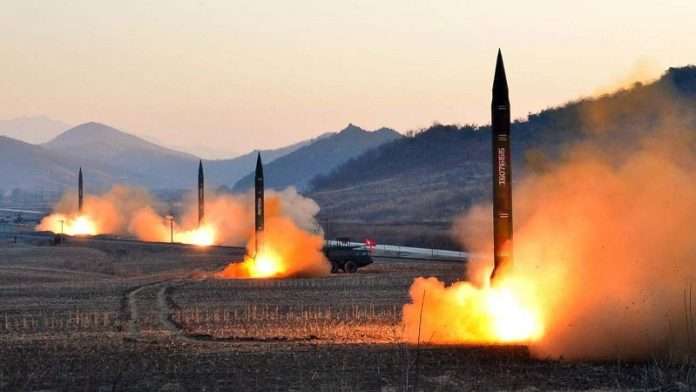We live in a world where geopolitical stability relies largely on deterrence. But how can we prove that deterrence works?
Consider the ongoing war in Europe. Beginning in December 2021, US President Joe Biden warned Russian President Vladimir Putin that Russia would face severe new sanctions if he invaded Ukraine, to no avail. Then, when the United States and its European allies thwarted Russia’s plans by providing arms to Ukraine, Putin brandished the nuclear option. But Western aid continued unabated.
Did deterrence fail or succeed? Answering this question poses a challenge because it requires assessing what would have occurred absent the threat. It is hard to prove a negative. If I put a sign on my front door saying, ‘No Elephants’, and there are no elephants in my house, did I deter them? It depends on the likelihood of literate elephants entering in the first place.
The Ukraine war demonstrates how risk reduction is not always an either/or choice, but often a matter of degree. Perhaps Putin, counting on a flimsy Western alliance, believed the sanctions would fail. But he has so far refrained from striking supply lines in NATO countries. And while the West, for its part, has continued to arm Ukraine despite Putin’s nuclear saber-rattling, it has been reluctant to provide longer-range missile systems or modern warplanes.
Credibility is essential for deterrence to work: threatening a maximum response to defend a minor interest strains credulity. This is particularly true when a nuclear power promises to extend its umbrella to defend a distant country.
During the Cold War, the US and the USSR credibly extended their nuclear deterrence to Western and Eastern Europe, respectively. While some analysts were skeptical that the US would risk New York to defend the isolated enclave of West Berlin, the threat worked, partly because of the American troops stationed there. While the so-called Berlin Brigade was too small to defend against a Soviet invasion, it ensured that a nuclear strike on the city would result in American casualties. (At the same time, US forces in Europe, both nuclear and conventional, were not a credible deterrent for Soviet military intervention in Hungary in 1956 or Czechoslovakia in 1968.)
This history is relevant to the current situation in Korea, where North Korea has nuclear weapons and South Korea remains bound by the Non-Proliferation Treaty. One recent poll found that more than 70 percent of South Koreans were in favor of their country developing its own nuclear arsenal. Instead, when South Korean President Yoon Suk-yeol met with Biden in April, they agreed that the US would station a nuclear-armed submarine near the Korean Peninsula and deepen consultations with South Korea on nuclear and strategic planning, similar to US engagement with NATO allies during the Cold War.
The credibility of US-extended deterrence in this instance, much like in the Berlin example, is reinforced by the presence of 28,500 US troops in South Korea. The two countries are locked in a ‘community of fate’ because North Korea cannot attack South Korea without killing Americans. Forward bases in Japan offer the same guarantee. That is why former US President Donald Trump’s frequent musings about the withdrawal of troops from places like Japan and South Korea were so damaging.
Trump’s presidency also highlighted the ineffectiveness of nuclear intimidation and bribes. When North Korea successfully tested an intercontinental ballistic missile in 2017, Trump threatened “fire and fury like the world has never seen,” to no effect. Next, he tried direct diplomacy. After meeting with North Korean dictator Kim Jong-un in 2018 — a long-sought foreign-policy goal for the North — he brashly predicted the swift demise of the country’s nuclear-arms program. To no one’s surprise, North Korea did not disarm. As Kim sees it, his reputation and the fate of his family dynasty depend on nuclear weapons.
The case of Taiwan, which China regards as its territory, shows how changing circumstances can test tried-and-true deterrence strategies. When President Richard Nixon and Chairman Mao Zedong met in 1972 to restore relations between the US and China, they did not see eye to eye on Taiwan’s status. Ultimately, the two sides designed a formula to postpone the matter: the US would recognize ‘one China’, the People’s Republic on the mainland, but only acknowledge that people on both sides of the Taiwan Strait were Chinese. The US provided weapons to Taiwan in accordance with the Taiwan Relations Act but did not recognize it as a sovereign country.
For many years, the US refused to say whether it would defend Taiwan. When I visited Beijing as a Pentagon official in the Clinton administration, my hosts asked if our countries would go to war over Taiwan. I replied that no one could know, noting that even though Secretary of State Dean Acheson failed to include South Korea in America’s defense perimeter in his 12 January 1950 speech, the US entered the Korean War only six months later. Relying on what the deterrence theorist Thomas Schelling called ‘the threat that leaves something to chance’, I warned the Chinese against testing us.
What some call a policy of ‘strategic ambiguity’ might better be described as ‘double deterrence’, designed not only to prevent China from using force against the island but also to dissuade Taiwan from declaring de jure independence. Now some analysts worry that this strategy is eroding as China’s military might grows and US lawmakers visit Taiwan in greater numbers. On four separate occasions, Biden has stated that the US would defend Taiwan, only for the White House to follow up each time with a statement reaffirming adherence to the ‘one China’ policy. In this context, steering a path that avoids projecting weakness or provoking escalation will be decisive for avoiding all-out war.
History reminds us that assessing a deterrent’s success can be difficult. There are some factors, like credibility, that are crucial to achieving the desired outcomes. But as dilemmas of deterrence continue to evolve and multiply, studying the strategy’s limits is equally important for finding an approach that works.
 Joseph S. Nye
Joseph S. Nye
A professor at Harvard University and a former US assistant secretary of defense, is the author, most recently, of Do Morals Matter? Presidents and Foreign Policy from FDR to Trump.
Copyright: Project Syndicate, 2022.
www.project-syndicate.org

















